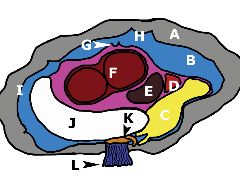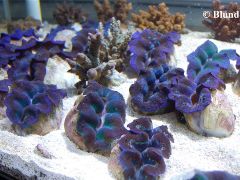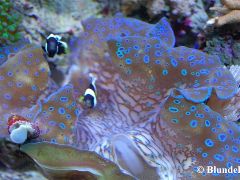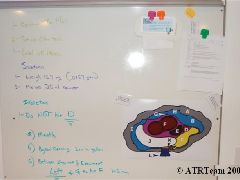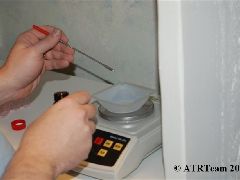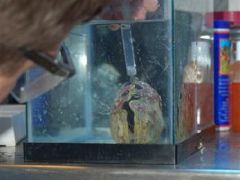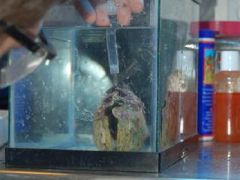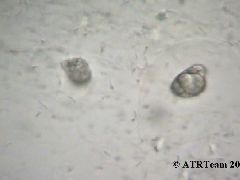Artikel mit freundlicher Genehmigung von www.ReefBuilders.com
Einführung
Giant Clams are amazing. Let me just start by saying that. The members of the family Tridacnidae are also known as the Tridacnids or as the Giant Clams. These animals are truly amazing. Within the phylum Mollusca there are about 115,000 species on Earth, with 30,000 of them contained in the Bivalvia class (Bivalves). Of those 30,000 bivalves a whopping 8 belong to the Family Tridacnidae. It is safe to say that in the grand scheme of things they are certainly oddities. That isn’t to say they are rare in numbers of individuals, just odd from an evolutionary standpoint.
Tridacnids are amazing for several reasons. To me, the most underappreciated fact is that they are photosynthetic.Well, that is to say they contain zooxanthellae which are photosynthetic. I won’t go into zooxanthellae here because I’m sure the readers of this article are quite familiar with symbiosis systems from their experience with corals. And that is just my point!Zooxanthellae and corals go together like peanut butter and jam. Zooxanthellae and clams go together like peanut butter and ice cream; it isn’t that common but it works for a few. The fact that these moluscs have developed the ability to house zooxanthellae is truly unique. In fact clam guru James Fatherree has clearly stated that the zooxanthellae found in Tridacnids is able to produce all of the energy needed by these animals (Fatherree 2006). This makes them a perfect candidate for home aquaria… which we’ll get to later.
Understanding Tridacnid Physiology
What has a heart and kidneys but no brain?….. you guessed it, a Clam.
Clams “work” by letting water flow into their mantle cavity through an inhalant siphon and then out an exhalent siphon. While inside the mantle cavity the water passes by the gills and allowing for gas exchange and for nutrient collection.
How exactly does the water move through the clam? Well it is possible that a clam could use muscular contractions to push water (and indirectly pull water) into the tissue. This however is something I have not seen.Like many sponges it is thought that as water passes quickly over the top of the clam (near the exhalent siphon) it draws water from within the clam upward. As this water moves out of the clam the surrounding water would flow into the inhalant siphon to take its place. This may be working but it would seem that orientation would be important (meaning does the clam face forward, sideways or backwards to the direction of the current). According to Fatherree (personal communication in 2007) this orientation does not appear to be important in clam health and growth.Indeed many photos I’ve seen show up to a dozen clams all living right beside each other and all scattered about without any form of direction.
From Fatherree 2007: A) shell B) mantle cavity C) digestive organs D) heart E) kidneys
F) muscles G) anus H) exhalent siphon I) inhalent siphon J) gills
K) byssal organ and foot L) byssus
Fütterung
Ich kann mit Sicherheit sagen sie fressen. Sie fressen Phyto- und Zooplankton. Anything small that passes into their inhalant siphon is fair game. However, that is (or at least can be) a very small portion of their energy intake. Clams house zooxanthellae and the zooxanthellae (remarkably) have the ability to meet all the energy requirements of a clam.Don’t believe me? Look it up (Fatherree 2007).
Clams grow to a maximum size that is fickle.Genetics certainly play a huge role in this.Some species of clams are just big (T. gigas) and some are just small (T. crocea). However within each species there is a great amount of variation. Please, don’t look at the maximum size a clam can reach and hope for that. It would be far better to look at the average size of a species, but even that is a guess. Many clams grow quickly in an effort to reach reproductive size. Once there, the need to grow takes a back seat to the need to reproduce. Think of this as clam libido kicking in.
Shown here is the clam bed kept in the home aquarium of clam expert Shane Silcox
Aquarienhälterung
Clams are the ideal reef tank inhabitant. They are aquacultured, easy to keep, ship well, easy to feed, and non aggressive. Some aquarists also like the fact that clams are often quite beautiful. Here are some quick tips and thoughts regarding clams:
1- if you buy a large clam from a local pet store it is very possible that it has already reached its maximum size. For smaller clams they often grow quite quickly and require a lot of calcium and carbonate, so check those levels often.
2- clams need halides.
3- clams appear very different when viewed from above and not from the side.
4- cheap, environmentally friendly, and easy to keep
Basic clam husbandry is no different than most reef tanks. While it is possible to keep clams under “non metal halide” conditions it is a sure bet that metal halides will improve your chances of succeeding with clams. In fact many clams live for months under power compact bulbs yet the owner can’t see that the clam is slowly dieing.Get halides and do it right.
Feeding clams appears to be unnecessary. However detritus can be a great food source and some aquarists report phytoplankton as well. These filter feeders can certainly remove organics; they just may not need to.
And finally keep the water clean. Most reef aquarists are familiar with protein skimmers, water changes, and all that goes into keeping nutrient free clean water. This is also very important when keeping clams. Although quite tolerant of pollutants it is recommended the aquarium be kept as nutrient free as can be.
Shown here a pair of anemonefish hosting in a clam
Teil II Tridacnas zum Ablaichen bringen
Einführung
Im vorherigen Teil des Artikels habe ich über die vielen Gründe gesprochen die Aquarianer dazu bewegen Tridacnas zu halten. Um es nochmal kurz zusammenzufassen: Tridacnas sind ein perfektes Haustier. Für den fortgeschrittenen Aquarianer, oder sagen wir besser für den abenteuerlustigen Aquarianer, sind Tridacnas möglicherweise auch wundervolle Tiere für Aquakultur, Experimente und Beobachtungen.
What Has Been Done
Clams have come a long way. I’m most surprised by this because I don’t personally see many constituents pushing for advancements with clams, yet much progress has been made. Today thousands of clams are aquacultured. Many of these farmed clams end in the food system, but many find their way in to the marine ornamental industry. This is fabulous! Clams today are farmed in huge outdoor ponds and reaceways. It would be safe to say that the high price hobbyists pay for clams (compared to the food industry) has pushed the market towards the ornamental industry.
What Is On The Horizon
Clam farming may soon become a home-based project. It is quite probable and possible that clams will become commonly cultured animals. Imagine trading baby clams like trading coral frags. Imagine attending a fish geek conference and seeing a hobbyist with a tradeshow booth… with hundreds of baby clams for sale.
Reasons to Culture Clams
1) It can be done.
We are currently seeing great success with thousands of clams being commercially raised.
2) It is easy.
A very simple procedure and protocol has already been developed for simple clam culture.
3) Market availability.
You can sell clams all day long. Despite huge commercial aquaculture facilities already in place, many clams are still collected from reefs. Any local pet store can provide evidence that clams are selling as fast as ever before.
4) Cost effective.
One could argue the cost of time involved, but in terms of cash flow clams are cheap. They need just a few things to grow from larvae to adults: light, saltwater, fish poop.
5) High fecundity.
One spawning can occur in about 15 minutes. For some clams this can produce up to 500 million eggs. Just for a reference that means a hobbyist could have more clam eggs in one day than there are people in the entire United States. If only 1% of those larvae made it to market size that would still be twice as many clams as people in my home state. And that is from just one clam, on one day.
6) Space feasibility.
To culture a few dozen clams you would need a 10 gallon tank and a window sill. Even the most novice of hobbyists can convince their wife’s to give them that much room.
Spawning Clams
Thankfully I didn’t have to figure this out. Trial and error overseas has developed a great system for spawning clams. Some variations exist and have been covered well by Ellis and colleagues (Ellis 1998). Shown here is the procedure I follow.
A large whiteboard displays the procedure used in the lab
Adam’s Preferred Method (for more details please contact the author)Husbandry Stage
1- Obtain and house large reproductive sized clams. This size varies among the species, but for starters we’re looking at 5” Crocea clams.
2- Provide healthy conditions (lighting and carbonate sources).
Spawning Stage
1- Mix 16mg of Serotonin (5’-hydroxytryptamine) into 20ml of filtered seawater from the clam holding tank.
2- Have all beakers, containers, pipettes, and syringes labeled and in order.
Weighing out chemicals to stimulate clam spawning
Injection Stage
1- Select injection site. This varies from scientist to scientist but I currently subscribe to the theory of injecting BELOW the excurrent siphon. This is done nearly straight up and down by piercing through the mantle tissue into the internal organs.
2- Once you feel the needle make its way into the muscle mass or organ tissue, inject 2ml of the serotonin mixture (many authors recommend only 1ml).
3- Carefully remove needle and allow clam time to open back up.
The process of stimulating clams to spawn in captivity
Collecting Gametes
1- About 10 minutes after injecting clams the clam will begin to expel sperm. This can be easily pulled out with a pipette or by scooping it out with a cup. The sperm mixture is a cloudy white mixture.
2- About 10 minutes after the release of sperm you may get eggs. Not all clams are old enough and healthy enough to produce and release eggs. This is where proper selection of broodstock is important.
3- Collect the eggs mass, which looks very similar to the sperm released, except you can sometimes see granules (eggs) if you look closely. It should be noted that while I haven’t seen it reported before we noticed a difference in buoyancy between the sperm and eggs. In our tests the sperm floated upward into the water column while the egg mass decended down towards the base of the clam.
Clam releasing sperm into the water column
Fertilization
1- Mix the collected eggs solution into filtered seawater. I like to mix up enough water with the eggs to create a solution that is 1L in volume. And now prepare the sperm mixture. I have no way to really quantify the sperm count but I’ll do my best. Take all of the collected sperm from one clam and mix it with filtered seawater (from the clam holding tank). Mix enough water to make 500ml. From this solution I recommend using 5ml total for the fertilization process. This number will surely change with further studies but appears to be a good starting place this early in the research. The sperm are mixed with the eggs. WARNING- too little sperm is never a problem, too much sperm causes numerous problems. When in doubt, use less sperm.
2- The eggs are reported to be viable for 15 minutes post release from various sources. For this reason using sperm and eggs from several clams can be challenging as you are racing against time.
3- Fertilization in marine invertebrates is often instantaneous. Far more control factors and recognition sites are present on sperm-egg combinations than are found in animals like humans, dogs, horses, fishes. However, it should be noted that Tridacnids appear to be a bit of an anomaly as their fertilization process does not quickly prevent polyspermy. In fact it is quite easy to “over fertilize” an egg in laboratory settings. I hypothesize that this may also happen in natural conditions and may contribute to their very low success rate.
Tridacnid sperm and eggs as seen through a microscope
Grow Out Stages
1- This will be reported in the next installment of this series.
Conclusion
While the process of rearing clams is still in its infancy, the process of spawning clams is now a reality. It is my hope that this article will help encourage a handful of hobbyists to take the plunge.
Finally I’d like to thank two of my great friends. Clam gurus James Fatherree and Shane Silcox have provided the key ingredient for my clam studies… enthusiasm. My thanks to the two of you.
Glam Guru- Shane Silcox James Fatherree and Adam Blundell
Author Information
Adam Blundell M.S. is a hobbyist, lecturer, author, teacher, and research biologist.Adam works for the University of Utah’s School of Medicine in Pathology and in Marine Biology.He currently helps run the Wasatch Marine Aquarium Society, of which he is a former president.Adam is also the director of the Aquatic & Terrestrial Research Team, a group which bridges the gap between hobbyists and scientists.Adam can be reached by his author forum.
References and Suggested Readings
Fatherree, J. (2007) “Giant Clams in the Sea and the Aquarium”. Liquid Medium. Tampa, Florida. USA.
Norton, J.H., Jones, G. (1992) “The Giant Clam: An Anatomical and Histological Atlas”. ACTAR Monograph Series No 14 Canberra, Australia.
Ellis, S. (1998) “Spawning and Early Larval Rearing of Giant Clams (Bivalvia: Tridacnidae)”, Center for Tropical and Subtropical Aquaculture






